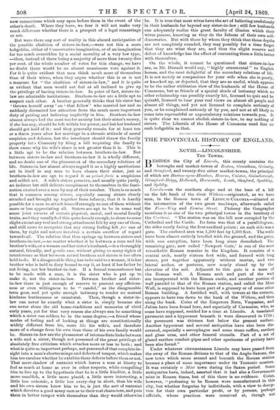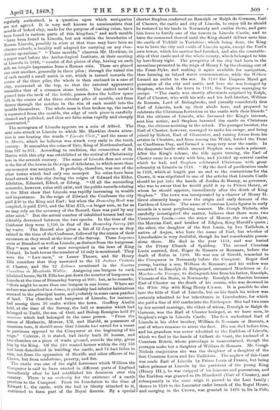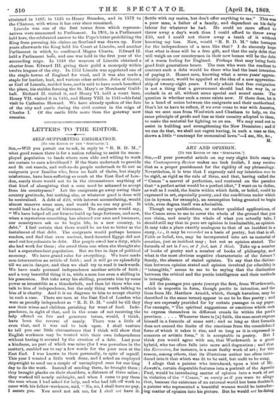THE PROVINCIAL HISTORY OF ENGLAND,
XCVILL—LINCOLNSHIRE. THE TOWNS. 13 ES ID E S the City of Lincoln, this county contains the boroughs and market-towns of Boston, Grantham, Grimsby, and Stamford, and twenty-five other market-towns, the principal of which are Barton-upon-Humber, Bourne, Caistor, Gainsborough, Glamfonl-Brigg, Holbeach, Horncastle, Louth, Sleaford, Spalding, and Spilsby.
Lincoln—on the southern slope and at the base of a hill on the left bank of the river Witham—originated, as we have seen, in the Roman town of LINDCM-COLONIA—situated at. the intersection of the two great roadways, afterwards called the Fosse-Way and Ermine Street. Ptolemy the Geographer mentions it as one of the two principal towns in the territory of the Coritani. "The station was on the bill now occupied by the Cathedral and the Castle. Its form was that of a parallelogram,. the sides nearly facing the four cardinal points ; on each side was a gate. The enclosed area was 1,200 feet by 1,300 feet. The walls have been almost entirely levelled with the ground, and the gates, with one exception, have been long since demolished. The remaining gate, now called Newport Gate,' is one of the most remarkable Roman remains in the kingdom. It consists of a central arch, nearly sixteen feet wide, and formed with long stones, put together apparently without mortar, and two lateral arches, or posterns, now nearly closed up by the elevation of the soil. Adjacent to this gate is a mass of the Roman wall. A Roman arch and part of the wall are incorporated with the Roman castle, and another portion of wall parallel to that of the Roman station, and called the Mint Wall, is supposed to have been part of a granary or of some other Roman building. A fortified wall, with towers at the corners,. appears to have run down to the bank of the 1Vithani, and then along the bank. Coins of the Emperors Nero, Vespasian, and Julian have been found here, and especially of Carausius, who, as some have supposed, resided for a time at Lincoln. A teaselated pavement and a hypocaust beneath it were discovered in 1739; the pavement was thirteen feet below the present surfaceAnother hypocaust and several antiquities have also been discovered, especially a sarcophagus and some stone coffins, earthen and glass urns, and other funeral utensils. Part of a set of glazed earthen conduit-pipes and other specimens of pottery have been also found."
Under whatever circumstances Lincoln may have passed from the sway of the Roman-Britons to that of the Anglo-Saxons, the new town which arose around and beneath the Roman station became a place of some importance under its Teutonic masters. It was certainly a Mint town during the Saxon period. Some antiquaries have, indeed, asserted that it had also a Government mint in Roman times, but of this there is no evidence. Coins: however, "professing to be Roman were manufactured in this city, but whether forgeries by individuals, with a view to deception for their own particular profit, or by persons, perhals* officials, whose practices were connived at, though not regularly authorized, is a question upon which antiquaries are not agreed. It is very well known to numismatists that moulds of baked clay, made for the purpose of casting coins, have been found in various parts of this kingdom," and such moulds "have been found in Lincoln, but not within the boundaries of Roman Lincoln, possibly in what at that time may have been an obscure suburb, a locality well adapted for carrying on any clandestine operations." "These moulds," observes Mr. Hawkins, in a paper read before the Archmological Institute, at their meeting at Lincoln in 1848, "consist of flat pieces of clay, having on each side an intaglio impression from a Roman coin. These are placed one over another, generally in three piles ; through the raised rim of each mould a small notch is cut, which is turned towards the centre of the three piles, the whole is then enclosed in a case of clay, contracted at the top, so that the external appearance resembles that of a common stone bottle. The melted metal is poured into the neck of the bottle, passes down the hollow Space left in the centre of the three circular piles of moulds, and from thence through the notches in the rim of each mould into the moulds themselves. The whole mass is then broken up, the metal is separated from the moulds, the edge of each piece is carefully cleaned and polished, and thus are false coins rapidly and cheaply constructed."
The monogram of Lincoln appears on a coin of Alfred. The next coin struck at Lincoln to which Mr. Hawkins draws attention is one bearing the words " Lincola Cilia.," and the name of St. Martin, which he believes was struck very early in the tenth century. It resembles the coins of Eric, King of Northumberland, from 927 to 951. According to tradition, the connection of St. Martin with this city was established at the revival of Christianity here in the seventh century. The name of Lincoln does not occur in the list of the towns in the reign of Athelstan, to which more than one moneyer was assigned. It probably, therefore, was one of the other towns which had only one moneyer. No coins have been found struck in this city during the reigns of Edward the Elder, Athelstan, Edmund, Edred, or Edwig. "Of all the succeeding monarchs, however, coins still exist, and the public records relating to the Mint show that Lincoln was rapidly increasing in wealth and importance. In the reign of Edward the Confessor the city paid £30 to the King and Earl ; but when the Domesday Book was compiled, it paid £.100, and the Mint 175,—a larger sum, so far as we may rely on the accuracy of the Record, than was paid by any other mint." But the actual number of inhabited houses had considerably decreased between the two epochs. In the time of the Confessor they were 1,150, in that of the Domesday Survey 240 lay waste. The Record also gives a list of 12 Lage men as they existed in the time of the Confessor, followed by the names of their successors as they stood at the time of the Survey. These Lagemen occur at Stamford as well as Lincoln, as distinct from the burgesses. They "were an order of men recognized in the laws of King Edward. In both towns the number of 12 only is mentioned. They were the "Law-men," or Lesser Thanes, and Sir Henry Ellis considers that they answered to the 12 .1-mikes Civitatis at Chester, and the 12 Lahmen mentioned in the Senatus Consultunt de Monticolis Minim. Assigning one burgess to each inhabited house, Sir H. Ellis has put down the number of burgesses in Lincoln at the time of Domesday Survey at 900; but, as he remarks, "there might be more than one burgess in one house. Where sac and soc was attached to a domus, it probably had inferior habitations annexed to the principal house, and probably in some cases patches of land. The churches and burgesses of Lincoln, for instance, had among them 36 crofts within the town. Geoffrey Alselin held, at the time of the Survey, the hall or mansion which had belonged to Tochi, the son of Outi, and Bishop Remigius held 30 mansions which had belonged to the same person. "From the names of Merlesvin, Morcar, Ulf, and Harold, as possessors of mansions here, it should seem that Lincoln had served for a resort to partizans opposed to the Conqueror at the beginning of his reign." Colsven, it is stated, had lately built 36 houses, and two churches on a piece of waste ground, outside the city, given lum by the King. Of the 240 wasted houses within the city 166 had been demolished in building the castle, and 74 had fallen to rUrn, not from the oppression of Sheriffs and other officers of the Crown, but from misfortune, poverty, and fire.
The castle was one of the eight fortresses which William the Conqueror is said to have erected in different parts of England immediately after he had established his dominion over this Country. There is no authority for the existence of a castle Previous to the Conquest. From its foundation to the time of Edward I., the castle, with the bail or liberty attached to it, continued to form part of the Royal domain. By a special charter Stephen conferred on Ranulph or Ralph de Gernons, Earl of Chester, the castle and city of Lincoln, to enjoy till he should be restored to his lauds in Normandy and castles there, and gave him leave to fortify one of the towers in Lincoln Castle, and to have the command thereof until the King should deliver unto him the castle of Tiekhill in Yorkshire ; which being done, the King was to have the city and castle of Lincoln again, except the Earl's own tower, which his mother had fortified, anti also the constableship of that castle and of the whole county, Which belonged to him by hereditary right. The prosperity of the city had been in the meantime promoted in the reign of Henry I. by the cleaning-out of the Fosse-Dyke, and making it again available for navigation, thus forming an inland water communication, while the 'Vishnu& formed an outlet to the sea. In 1140 the Empress Maud got possession of the city and castle, and here she was besieged by Stephen, who took the town in 1141, the Empress managing to escape. " The castle was shortly afterwards surprised by Ralph, Earl of Chester, who with his wife and his half-brother, William de Romara, Lord of Bolingbroke, and (usually considered) first Earl of Lincoln, took up their abode here, and prepared to celebrate the Christmas festivities in the castle with their friends." But the citizens of Lincoln, who favoured the King's interest, sent him notice, and Stephen invested the castle on Christmas Day, the citizens assisting in the attack. The younger brother, the Earl of Chester, however, managed to make his escape, and being joined by Robert, Earl of Gloucester, anti raising forces from his estates in Cheshire, and from among the Welsh, forded the Trent on Candlemas Day, and formed a camp very near the castle. In the desperate battle which ensued Stephen was made a prisoner. After the King's release, the tide again turning, the Earl of Chester came to a treaty with him, and yielded up several castles which he had, and Stephen celebrated Christmas with great solemnity at Lincoln in 1144. "By the deed of pacification made in 1153, which at length put an end to the contentions for the Crown, it was stipulated in one of the articles that Lincoln Castle should be put into the hands of Jordan de Hussey, as governor, who was to swear that he would yield it up to Prince Henry, or whom he should appoint, immediately after the death of King Stephen." The town was incorporated by a charter of Henry IL Great obscurity hangs over the origin and early descent of the Earldom of Lincoln. The name of Countess Lucia figures in early records in a most perplexing manner. Mr. Gough Nichols, who carefully investigated the matter, believes that there were two Countesses Lucia,—one the sister of Morcar, the son of Algar, the Mercian Earl, and brother of Edgiva, King Harold's queen ; the other, the daughter of the first Lucia, by Ivo Taillebois, a native of Anjou, who bore the name of Earl, but whether of Lincolnshire is very doubtful, though he had considerable possessions there. He died in the year 1114, and was buried in the Priory Church of Spalding. The second Countess Lucia married, first, Roger de Romara or Roumare, before the death of Rufus in 1100. Ile was son of Gerold, seneschal to the Conqueror in Normandy before the Conquest. Roger died young, leaving a son, William de Rouroare, and his widow was remarried to Rauulph de Briquesard, surnamed Meschinea or Le Meschin—the Younger, to distinguish him from his father, Ranulph, Vicomte of the Begin, in Normandy. Itanulph de Meeehin became Earl of Chester on the death of his cousin, who was drowned in the White Ship with King Henry l.'s son. It is possible he also bore the title of Earl of Lincoln, but on his death his widow was certainly admitted to her inheritance in Lincolnshire, for which she paid a fine of 400 marks into the Exchequer. She had two sons by her second marriage, the eldest of whom, Itanulph or Ralph de Gernous, was the Earl of Chester besieged, as we have seen, in Stephen's reign in Lincoln Castle. The first undoubted Earl of Lincoln is his elder brother, William de 119umare or Romara, a seal of whose remains to attest the fact. His sou died before him, and his grandson was never admitted to the Earldom of Lincoln, which we find in the hands of Gilbert de Gaut, the husband of a Countess Robeis, whose parentage is unaseertained, though the peerages make her a daughter of William de Romara. Mr. Gough Nichols conjectures she was the daughter of a daughter of the first Countess Lucia and ho Taillebois. The nephew of this Gant was made Earl of Lincoln by Prince Louis of France, but being taken prisoner at Lincoln by the partizans of the young King (Henry HI.), he was stripped of his honours and possessions, and the Earldom was granted to De Blundevill (Earl of Cheater), and subsequently in the same reign it passed to the Laci family ; thence in 1349 to the Lancaster cadet branch of the Royal House, and merging in the Crown, was granted in 1476 to De Is Pole, attainted in 1487; in 1525 to Henry Brandon, and in 1572 to the Clintons, with whom it has ever since remained.
Lincoln was one of the first towns from which representatives were summoned to Parliament. In 1301, in a Parliament held here, the celebrated answer to the Pope's letter prohibiting the King from pursuing. his claims on Scotland was drawn up. Four years afterwards the King held his Court at Lincoln, and another Parliament in which he confirmed Magna Charta. Edward H. held a Parliament here, and one was held in the first year of the succeeding reign. In 1348 the weavers of Lincoln obtained a charter from Edward III. giving their guild a monopoly within twelve leagues of the city. In 1352 Lincoln was appointed one of the staple towns of England for wool, and it was also made a staple for leather, lead, and various other articles. John of Gaunt, as Earl of Lincoln, resided here, and is said to have much benefited the place, his stables forming the St. Mary's or Merchants' Guildhall. Richard II. visited it, and Henry VI. held a court here, Henry VII. visited it in 1485, and Henry VIII. in 1541—his fatal visit to Catherine Howard. We have already spoken of the fate of the city and castle during the civil contest in the reign of Charles I. Of the castle little more than the gateway now remains.
































 Previous page
Previous page